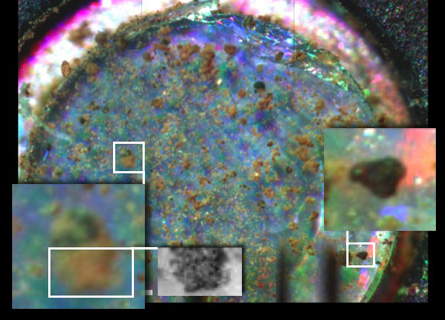- More than 2 years ago
The Phoenix Lander has sent back the most-detailed view of the Red Planet’s soil to date.

Not since the Viking Landers, in the 1970s, has a spacecraft scooped and tested Martian dirt to learn more about the composition of Mars, said Peter Smith, the mission’s principal investigator, in a news conference Friday.
On June 12, using an optical microscope inside one the lander’s instruments, the Phoenix science team took the highest resolution image of individual soil grains. The team can now begin to identify, in great detail, the minerals making up the north polar region of Mars.
The bigger particles are a little less than the diameter of a human hair, about 50 micrometers in size, said Tom Pike, a coinvestigator from Imperial College London who used the Microscopy, Electrochemistry and Conductivity Analyzer or MECA, which houses the optical microscope.
Going on color alone, he said, the team has detected the mineral olivine, which has a greenish tinge. In the same image, the team saw the characteristic iron-enriched reddish, orange soil grains that cover all of Mars. The scientists even picked out smooth, black particles that indicate the presence of volcanic glass.
“What we are looking at is the past history of Martian soil,” Pike said. “The black, glassy material has been there for millions or billions of years, and the iron-enriched grains tell about weathering that has gone on for that period of time.”
The new microscopic images are the first scientific evidence from which the team can draw conclusions about the planet’s polar soil. Early next week, the lander will transmit data from the spacecraft’s other instruments to reveal information about the region’s salt and ice content.
“Stay tuned,” Smith said, “and we will see what is under the surface.”







